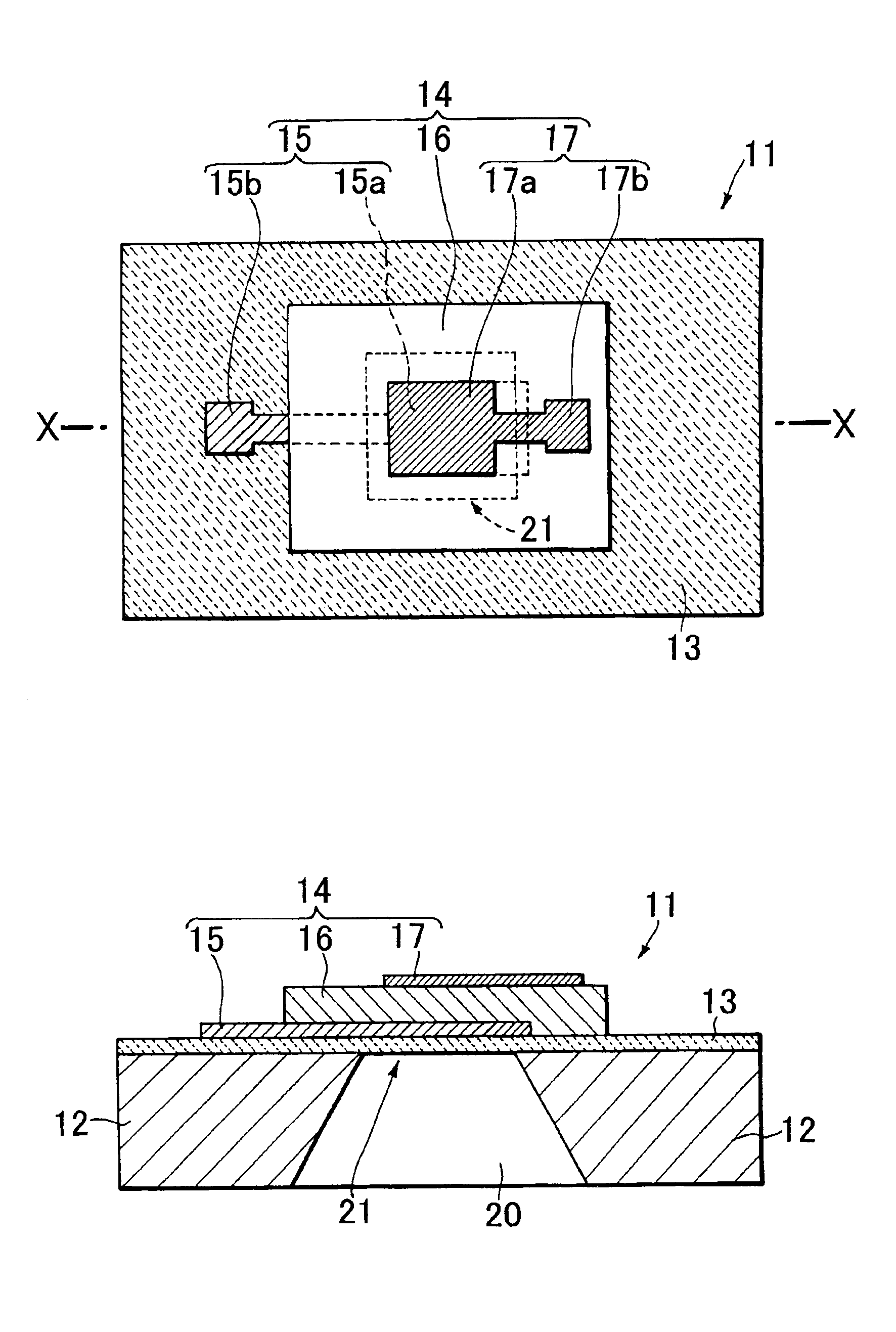Film bulk acoustic resonator
a resonator and bulk technology, applied in the direction of bulk negative resistance effect devices, electrical equipment, semiconductor devices, etc., can solve the problem that the performance of thin film resonators or thin film band-pass filters which cannot meet the giga-hertz band has not been obtained, and achieves high crystallinity, convenient growth, and superior characteristics.
- Summary
- Abstract
- Description
- Claims
- Application Information
AI Technical Summary
Benefits of technology
Problems solved by technology
Method used
Image
Examples
example 1
[0120]In the present example, the thin film bulk acoustic resonator having the structure shown in FIGS. 1, 2 was prepared as follows.
[0121]That is, a silicon nitride (SiNx) layer having a thickness of 0.55 μm was formed on the upper and lower surfaces of the (100) Si substrate 12 having a thickness of 250 μm by a low-pressure CVD method. The SiNx layer on the upper surface was formed as the base film 13. Moreover, the SiNx layer on the lower surface was formed in a pattern of a mask for forming the via hole described later with respect to the substrate 12.
[0122]A Mo layer having a thickness of 200 nm was formed on the surface of the base film 13 by a DC magnetron sputtering method, and patterned by photolithography to form the lower electrode 15. The main portion 15a of the lower electrode 15 was formed in the shape close to a rectangular shape having a plane dimension of 140×160 μm. It was confirmed by X-ray diffraction measurement that the lower electrode 15 was the single orienta...
examples 2 to 4
[0126]In each of the present examples, the thin film bulk acoustic resonator having the structure shown in FIGS. 1, 2 was prepared as follows.
[0127]That is, a silicon oxide (SiO2) layer having a thickness in a range of 0.2 to 0.7 μm was formed on the upper and lower surfaces of the Si substrate 12 having a thickness of 300 μm by a thermal oxidation method. The SiO2 layer on the upper surface was formed as the base film 13. Moreover, the SiO2 layer on the lower surface was formed in the pattern of the mask for forming the via hole described later with respect to the substrate 12.
[0128]A stacked film of a 15 nm thick Ti layer and a 100 nm thick Pt layer on the Ti layer was formed on the surface of the base film 13 by the DC magnetron sputtering method, and patterned by the photolithography to form the lower electrode 15. The main portion 15a of the lower electrode 15 was formed in the shape close to the rectangular shape having a plane dimension of 140×160 μm. It was confirmed by the ...
examples 5
[0132]In the present example, the thin film bulk acoustic resonator having the structure shown in FIGS. 3, 4 was prepared as follows.
[0133]Steps similar to those of Example 1 were carried out except the shapes and dimensions of the upper and lower electrodes 15, 17. The lower electrode 15 was formed in the rectangular shape having a plane dimension of 120×280 μm so as to extend while including the region corresponding to the vibratory section 21. For the upper electrode 17, the main portions 17Aa, 17Ba each having the shape close to the rectangular shape having the plane dimension of 65×85 μm were arranged at an interval of 20 μm.
[0134]With respect to the thin film bulk acoustic resonator (FBAR) obtained in the above-described steps, the composition of the AlN piezoelectric film 16 was analyzed by the XPS spectroscopy. Moreover, the multifunctional X-ray diffraction apparatus for the surface structure evaluation was used to carry out the thin film X-ray diffraction measurement by th...
PUM
 Login to View More
Login to View More Abstract
Description
Claims
Application Information
 Login to View More
Login to View More - R&D
- Intellectual Property
- Life Sciences
- Materials
- Tech Scout
- Unparalleled Data Quality
- Higher Quality Content
- 60% Fewer Hallucinations
Browse by: Latest US Patents, China's latest patents, Technical Efficacy Thesaurus, Application Domain, Technology Topic, Popular Technical Reports.
© 2025 PatSnap. All rights reserved.Legal|Privacy policy|Modern Slavery Act Transparency Statement|Sitemap|About US| Contact US: help@patsnap.com



